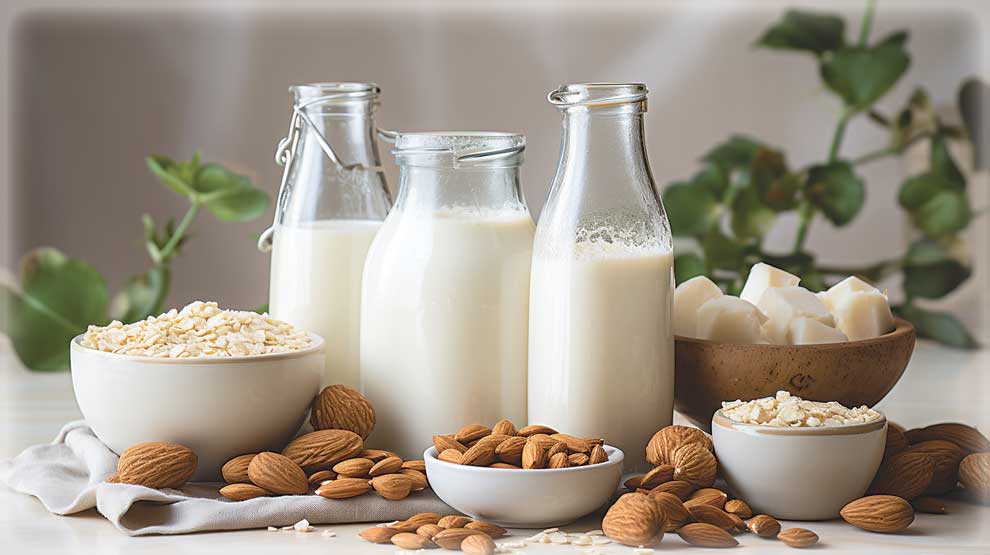One of the topics I am frequently asked about as a pediatric registered dietitian is the ever-increasing number of types of milk and milk alternatives. It can be hard to sort through the options to determine which one(s) best meet your family’s needs. This article includes recommended amounts of milk, key nutrients for growing children, and considerations for choosing your best option.
How Much Milk for Kids?
Milk or appropriate milk alternatives are an easily prepared, child-friendly, and cost-effective way to provide several key nutrients for children’s growth and development. You don’t need to offer milk or an alternative; the nutrition can be provided from other dietary sources. However, if you choose this option, I recommend speaking with a pediatrician or dietitian to ensure nutritional needs are being met.
Recommended dairy amounts change as children grow, per the American Academy of Pediatrics:
- For under twelve months of age, neither cow’s milk or milk alternatives are recommended. It is recommended to provide breast milk or infant formula.
- For infants twelve to twenty-four months, two cups (16 oz) per day of whole milk are recommended.
- For toddlers two to four years old, two cups (16 oz) of low-fat milk are recommended.
- For children four to eight years old, two-and-a-half to three cups of low-fat dairy servings per day are recommended.
There is such a thing as too much dairy. If a child is drinking more than sixteen ounces (two to three cups) of milk in addition to consuming other dairy products like cheese, they are getting more than the recommended amount. Too much milk can make kids feel full throughout the day, causing them to not have enough variety in their diet and not get enough of other important nutrients, like iron and fiber. It’s a good idea to serve milk with meals or snacks. Sipping on milk over hours has food safety risks and can negatively impact appetite and dental health.
What About Milk Alternatives?
Some families offer a milk alternative for a variety of reasons, including allergies, family dietary patterns, nutrition, and taste preferences. It is important to consider several key nutrients when choosing a milk option, including calories, protein, vitamin A, vitamin D, and calcium. Oat milk and almond milk are two popular milk alternatives. Neither of these options should routinely be offered to young children. To best support growth, kids need a more concentrated amount of nutrients per sip, like protein or fat, than these milk alternatives provide.2
Milk and milk alternatives for young children¹
Whole cow’s milk²
Milk is available in lower fat options, which are lower in calories. Young children need a lot of energy to support growth, so it is best to serve whole milk until age two. (146 calories, 8 grams protein, 8 grams fat, 300 mg calcium, 80 mcg vitamin A, 2 mcg vitamin D) Flavored milks should not be offered before two years of age. After age two, flavored milks can be offered occasionally to limit added sugar.
Soy milk³
Choose a soy milk that is fortified with calcium and vitamins A and D. Sweetened soy milk can be high in added sugars, something the American Academy of Pediatrics recommends limiting through age two, so aim to choose an unsweetened option¹. If offering soy milk, offer sources of healthy fat during the day. (80 calories, 7 grams protein, 4 grams fat, 300 mg calcium, 150 mcg vitamin A, 3 mcg vitamin D)
Pea protein milk4
Pea protein milk is soy, nut, and gluten free. Nutrition content can vary based on the brand, so always check the label. (100 calories, 8 grams protein, 4.5 grams fat, 440 grams calcium, 110 mcg vitamin A, 6 mcg vitamin D)
Oat milk5
Oat milk generally is low in protein. It also varies widely in nutritional content, depending on brand. (120 calories, 3 grams protein, 9 grams fat, 350 mg calcium, 160 mcg vitamin A, 3.6 mcg vitamin D)
Almond milk6
Almond milk is low in protein and fat. Sweetened almond milk can be high in added sugar. (30 calories, 1 gram protein, 2.5 grams fat, 450 mg calcium, 150 mcg vitamin A, 5 mcg vitamin D)
Choosing a milk or milk alternative that works best for your family depends on budget, taste preferences, availability, nutritional needs, and several other factors. While this article is not and should not replace individual nutrition counseling, it can serve as a guide and starting point to sort through all of the options available. If you have additional questions, ask your pediatrician or a dietitian.
References:
1 Muth, N. (2019, May). Recommended drinks for children five and younger.HealthyChildren.org.
2 USDA. Milk, Whole. FoodData Central.
³ Silk. Unsweet Soy Milk Silk.com
⁴ Ripple Foods. Original plant milk.
⁵ Oatly. Oatmilk. Oatly.com
⁶ Silk. Unsweet Almond Milk. Silk.com.





